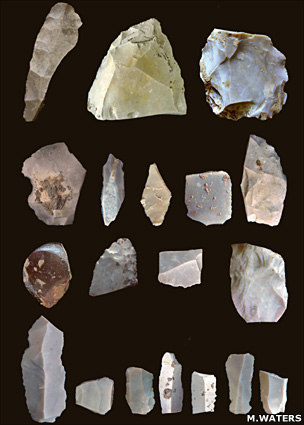First People in the Americas
The timeline gets pushed back again... still a pretty big gap.
Artifacts upend theory on first North Americans
A cache of 15,500-year-old artifacts found buried in a Texas flood plain predates the well-known Clovis people, long thought to be the first inhabitants of the New World.
—Thomas H. Maugh II, Los Angeles Times
Stone tools 'demand new American story'
A number of digs across the Americas in recent decades had already hinted that the "Clovis first" model was in serious trouble.But the huge collection of well-dated tools excavated from a creek bed 60km (40 miles) northwest of Austin mean the theory is now dead, argue the Science authors.
"This is almost like a baseball bat to the side of the head of the archaeological community to wake up and say, 'hey, there are pre-Clovis people here, that we have to stop quibbling and we need to develop a new model for peopling of the Americas'," Michael Waters, a Texas A&M University anthropologist, told reporters.
—Paul Rincon and Jonathan Amos, BBC News
Dig solidifies evidence that first Americans were here 15,000 years ago
The newly unearthed objects come from a site northwest of Austin, which has been under excavation for several years along a waterway known as Buttermilk Creek. They consist of relatively crude scrapers, knife blades, broken and half-repaired spear points, and more than 15,000 flakes and chips testifying to human workmanship. They bear some similarity to Clovis tools, although not a clear one.Whether the people who made them were related to the people who made the Clovis tools is uncertain. However, no bones or other DNA-containing materials were found, so the question can’t be answered.
“Cultural history and biological history do not have to go hand in hand. So there’s no way you can say they were related to each other,” said Eske Willerslev, director of the Center for GeoGenetics at the University of Copenhagen.
—David Brown, Washinton Post
People Were Chipping Stone Tools in Texas More Than 15,000 Years Ago
The area where the tools were found, northwest of Austin, must have been an appealing campsite for millennia, because it bears a record of nearly continuous occupation from 15,500 years ago. The discovery is detailed in a new study, published online March 24 in Science.When the makers of these tools were using the site (from 15,500 to 13,200 years ago), the region would have been slightly cooler than it is today, probably by an average of about 5 to 6 degrees Celsius—"rather amiable at that time period," Lee Nordt, of Baylor University's Department of Geology and co-author of the new study, said in a press briefing on Wednesday. But the resources in the area were likely plentiful, added Michael Waters, of the Center for the Study of the First Americans at Texas A&M University in College Station and co-author of the new study. With the rich hill country around them, "it's not surprising people came back time and time again."
The people who left the tools and fragments described in the study were likely hunter–gatherers, passing through the site from time to time over thousands of years. "This was a mobile tool kit—something that was easily transported," Waters said.
Katherine Harmon, Scientific American
About eighty-five thousand years ago the comparatively pure remnants of the red race went en masse across to North America, and shortly thereafter the Bering land isthmus sank, thus isolating them.
—Urantia Paper 64, The Evolutionary Races of Color, §6. The Six Sangik Races of Urantia, ¶5 (pg 725)
Fifteen thousand, eighty-five thousand... still a pretty big gap. On the other hand, they apparently were pretty well-established deep in the heart of Texas by this point.
Scientific Evidence of Space Respiration
Anthropology & The Urantia Book on hominid evolution
Humanity's Lemur-Like Asian Ancestry



